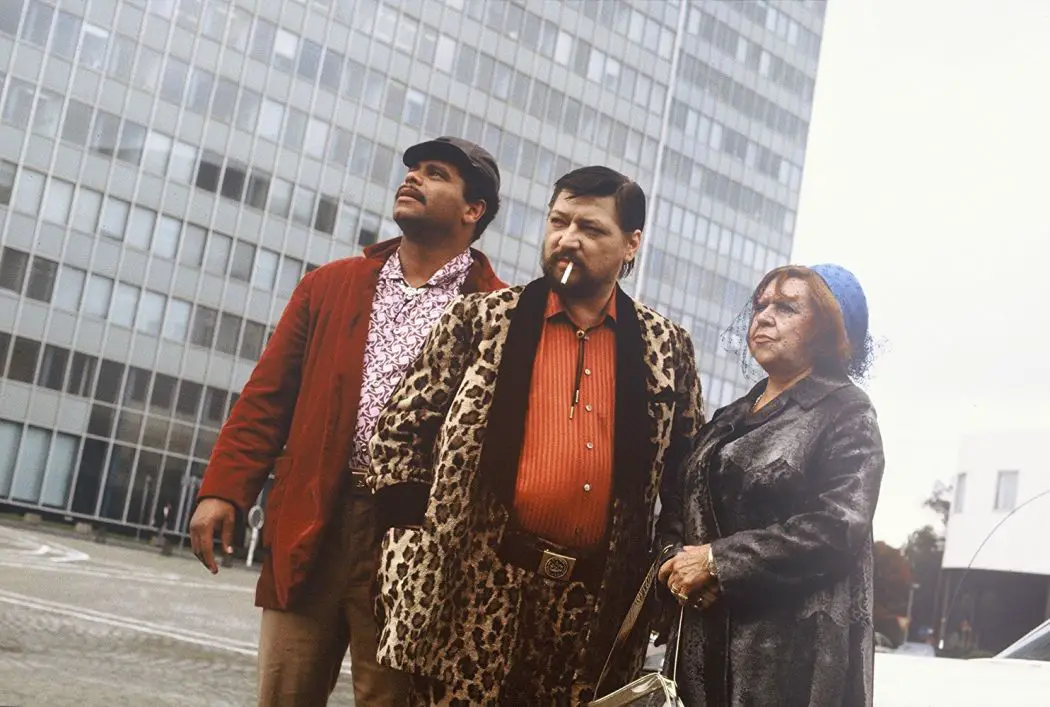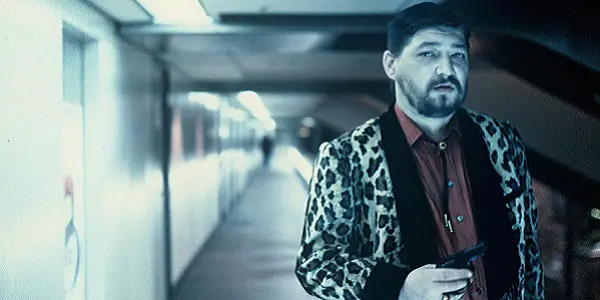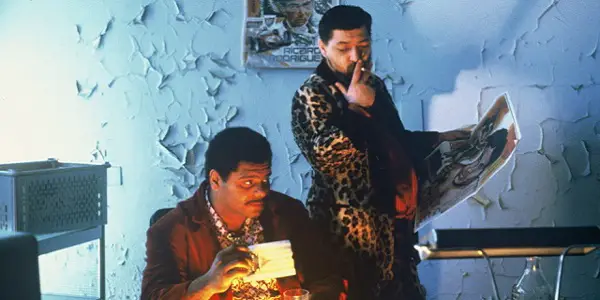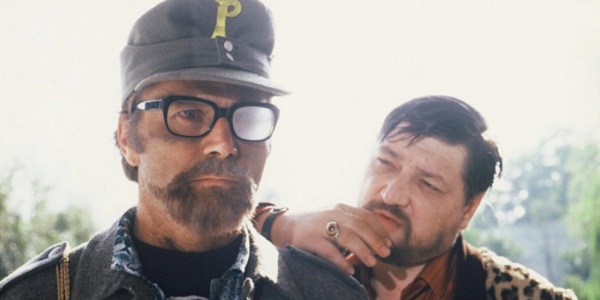KAMIKAZE 1989: A Fitting Farewell To Fassbinder

Lee Jutton has directed short films starring a killer toaster,…
Rainer Werner Fassbinder was a one-of-a-kind talent that burned so fiercely and so brightly that he burned out way too soon. The German auteur (one of the few filmmakers to ever truly deserve the term) died at age 37 after overdosing on cocaine and barbiturates. Yet during his short span of life, he managed to complete forty feature films and numerous other creative projects, including television series (most famously the Weimar-era epic Berlin Alexanderplatz), short films and plays.
Infamous for his volatility on- and off-set, his turbulent love affairs with both men and women, and the often controversial content of his work (accusations of anti-Semitism, sexism and even homophobia abound, despite his very public sexual relationships with several men), it is impossible to feel neutral about Fassbinder. You either love his work or you hate it – or, you just hate him, work be damned. He was, by all accounts, an incredibly difficult person to put up with – and that is putting it mildly.
The Fantastic Mr. Fassbinder
I adore Fassbinder; I know that I should not, for a variety of reasons, and yet I do anyways. His remarkable body of work explores important topics such as the xenophobia that persisted in post-war Germany (Katzelmacher, Ali: Fear Eats the Soul), the struggle of women to rise from the ashes of the Third Reich (his celebrated BRD Trilogy), and the dark side of human attraction – how it can lead us to betray and destroy each other and ourselves (The Bitter Tears of Petra von Kant, Fox and His Friends).
Visually, his style ranges from minimalist black-and-white stage adaptations shot on shoestring budgets (Love is Colder Than Death) to decadent, color-drenched melodramas (Lola) and everything in between. Many of his films were shot in only a few weeks – hence why he was able to complete so many – and yet the storytelling is more nuanced and impactful than in films that have spent years in development.

However, Fassbinder’s considerable ability behind the camera is not the only skill of his that deserves to be celebrated in 2017, which happens to be the 25th anniversary of his death. He was also an actor with a shockingly magnetic screen presence, who appeared onscreen in many of his own films and occasionally the films of others.
His final acting role was the lead in Kamikaze 1989, an over-the-top dystopian thriller that was released one month following his death in 1982. As Lieutenant Jansen, Fassbinder slouches around in an iconic leopard-print suit, his eyes squinting out of the bloated bulk of his face as he repeatedly demands that everyone else “refrain from making unnecessary remarks” so he can focus on solving the most difficult case of his celebrated career.
Every frame of the film is an energetic assault on the eyes. Now available for streaming on Sundance Now in a restored version that showcases all of its bizarre cyber-punk glory, Kamikaze 1989 is not a perfect film, but it is indeed the perfect film to bid farewell to one of the greatest and strangest cinematic talents of the 20th century.
Move Over, Poirot
Directed by Wolf Gremm and adapted by Gremm and Robert Katz from the 1964 novel Murder on the Thirty-First Floor by Per Wahlöö, Kamikaze 1989 portrays a world in which West Germany is a wealthy and peaceful country ruled by a totalitarian regime known as the Combine, which controls all aspects of media and entertainment.
The most popular program on the air? The annual Laughing Contest, in which several eccentric characters laugh and laugh for days on end until only one remains. The contest, which feels like something Charlie Brooker wishes he had thought up for Black Mirror, recurs in the background throughout the film; the CEO of the Combine boasts that 99% of the population is watching it.
It’s just one of the many wonderful oddball details – including the cartoonish thumbs up used as the police logo, Lieutenant Jansen’s infatuation with leopard print that extends to the upholstery of his car, and the absolutely electric electronic score by Edgar Froese of Tangerine Dream – that bring the near-future dystopia of Kamikaze 1989 to vibrant life.

Despite a slovenly appearance more reminiscent of a pimp than a police officer, and an addiction to alcohol that is illegal in this pseudo-utopian society, Lieutenant Jansen is an extraordinary cop; in his entire career, he has never not solved a case. However, his perfect record is put to the test when he is called to the Combine’s 30-floor headquarters (or are there 31? Hmmm…) to investigate a bomb threat.
The anonymous threat has been sent in via newspaper letters cut out and pasted to a rare piece of gold paper that was used by the Combine to issue awards to 25 extraordinary employees. With the help of his sidekick, Anton (frequent Fassbinder collaborator Günther Kaufmann), Jansen absorbs these clues and begins to investigate who might be responsible.
Is it the mysterious and beautiful Elena Farr (Petra Jokisch)? On-air personality Barbara (Nicole Heesters)? What about the references to counter-culture icon Krysmopompas, the nemesis of the Combine? Suspicious characters and disturbing occurrences – including several “premature deaths” – begin to clutter up Jansen’s mind and make it seem as though this will be the first case to get the better of him.
The plot of Kamikaze 1989 is reminiscent of Alphaville, but more nonsensical; the punk aesthetic echoes Escape from New York, but with more splashes of color and flashes of pattern (especially leopard print). Above all, it reminds one of Twin Peaks at its most iconically idiosyncratic. (One cannot help but mourn that David Lynch never got the chance to direct Fassbinder; that meeting of the minds would have blown up the movies.)
And like all of those cult classics, Kamikaze 1989 carries the audience along on the scrappy, charismatic shoulders of its protagonist – even when the plot spirals outward into insanity. The last half hour of the film doesn’t make much sense, but with Fassbinder there, it doesn’t need to in order to entertain.

“Refrain From Making Unnecessary Remarks”
There is something about Fassbinder’s onscreen presence that just makes him a joy to watch, whether he is being directed by himself or by another. There’s a brash confidence that often does not feel deserved and is thus all the more entertaining to behold, combined with a rare gift for comic timing that can elicit awkward laughter even in the darkest situations.
At one point in Kamikaze 1989, Jansen meets Elena Farr at her home, where she shows him numerous lifelike sketches she has done of him. “You have a good face for drawing,” she says, clear to emphasize the for drawing portion of her statement. Jansen’s vanity allows him to skim over this qualifier, however, as he eagerly flips through the sketches. “I like looking at pictures of myself,” he replies. One cannot help but stifle a laugh at his bravado, even as you cringe knowing how soon the end was coming for him. Yet Fassbinder seems to be having so much fun throughout Kamikaze 1989 that it makes knowing this was his last movie a little easier to bear.
The combination of dazzlingly detailed production design and Fassbinder’s final performance make it hard to tears one’s eyes away from the spectacle that is Kamikaze 1989. It forces you to think about what the future might hold while still reckoning with the problems of the present. It is flashy, freaky and incredibly German. It is the most fitting farewell one could bid to Rainer Werner Fassbinder.
What do you think? Does Fassbinder’s work remain relevant 25 years after his death? Share your thoughts in the comments below.
Kamikaze 1989 is currently available to stream on Sundance Now.
Does content like this matter to you?
Become a Member and support film journalism. Unlock access to all of Film Inquiry`s great articles. Join a community of like-minded readers who are passionate about cinema - get access to our private members Network, give back to independent filmmakers, and more.
Lee Jutton has directed short films starring a killer toaster, a killer Christmas tree, and a not-killer leopard. Her writing has appeared in publications such as Film School Rejects, Bitch: A Feminist Response to Pop Culture, Bitch Flicks, TV Fanatic, and Just Press Play. When not watching, making, or writing about films, she can usually be found on Twitter obsessing over soccer, BTS, and her cat.













